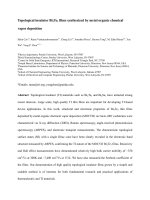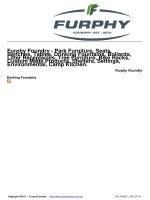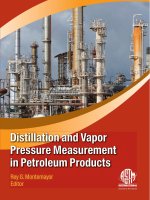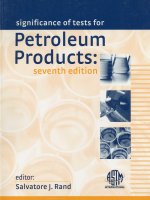Petroleum products handbook By Virgil B. Guthrie potx
Bạn đang xem bản rút gọn của tài liệu. Xem và tải ngay bản đầy đủ của tài liệu tại đây (12.56 MB, 973 trang )
xv
Contents
Contributing Editors vii
Preface xi
Guide for Handbook Users xiii
Petroleum Flow Chart from the Well through the
Refinery xv
Section 1. The Raw Material, Crude Petroleum
and Natural Gas 1-1
Part I. Petroleum, Our Man of all Work 1-1
Nature and Occurrence of Petroleum 1-3
How the Oil Industry Functions 1-6
Nature and Composition of Crude Oil 1-9
Transforming Crude Oil into Products 1-10
Products from Petroleum and Natural Gas 1-14
Bibliography 1-28
Part II. Natural Gasoline a Source of Liquid Products 1-30
Birth in the Early Pennsylvania Oil Fields 1-32
Research for Broader Markets 1-35
Wider Use in Motor Fuel 1-35
Specifications and Properties 1-37
xvi Contents
Testing Methods 1-37
References 1-38
Bibliography 1-38
Guide to Current and Primary Reference Data 1-39
Appendix A: Check List of Commercial Petroleum
Products 1-40
Section 2. Additives for Petroleum Products 2-1
General Properties of Additives 2-3
Selection and Control of Additives 2-4
Liquid Fuel Additives 2-6
Additives for Automotive Lubricants 2-18
Additives in Oil Specifications 2-24
Additives for Industrial Oils 2-30
Bibliography 2-42
Section 3. Liquefied Petroleum Gas 3-1
Properties of LP-Gas Hydrocarbons 3-2
Production and Treating of LP-Gas 3-6
Specifications and Test Methods 3-10
Storage and Handling of LP-Gas 3-13
Rules, Regulations, and Standards 3-18
Distribution Methods 3-21
Utilization of LP-Gas 3-25
Sizing of Tanks and Piping 3-29
Receipt of Shipments 3-30
Taxes Applicable to LP-Gas 3-34
Toxicity of LP-Gas Hydrocarbons 3-35
Securing Maximum Performance 3-35
References 3-39
Contents xvii
Glossary of Liquefied Petroleum Gas Terms 3-40
Guide to Current and Primary Reference Data 3-46
Section 4. Gasoline 4-1
General Performance Requirements 4-6
Chemical Composition of Gasoline 4-8
Motor Fuel Gasoline 4-11
Alcohol Blends 4-37
Aviation Gasoline 4-38
Marine Gasoline 4-42
Gasoline Tractor Fuel 4-44
References 4-45
Bibliography 4-47
Appendix A: Tentative Specifications for Gasoline 4-48
Appendix B: Tentative Specifications for Aviation
Gasolines 4-51
Guide to Current and Primary Reference Data 4-54
Section 5. Aircraft Gas Turbine Fuels and
Lubricants 5-1
Principles of Operation and Types 5-2
Fuel Developments and Specifications 5-6
Aircraft Gas Turbine Fuel Manufacture 5-10
Fuel Requirements and Properties 5-10
Aircraft Gas Turbine Lubricants 5-23
References 5-27
Section 6. Diesel Fuel Oils 6-1
Diesel Fuel Economics 6-1
Composition of Fuel an Important Factor 6-4
xviii Contents
Properties Determining Fuel Performance 6-5
Test Methods for Diesel Fuel Oils 6-9
Significance of Tests on Diesel Fuels 6-12
Utilization of Diesel Fuels 6-13
Growth Trends in Diesel-Engine Field 6-29
Storage, Shipping, and Handling 6-31
References 6-32
Bibliography 6-32
Guide to Current and Primary Reference Data 6-33
Section 7. Distillate Heating Oils 7-1
Status of the Heating-Oil Industry 7-3
Burners, Controls, and Tanks 7-9
Central-Heating Systems 7-15
Specifications and Testing 7-24
Burning Qualities in Oils 7-28
Stability in Heating Oils 7-37
Handling and Delivery 7-46
References 7-50
Bibliography 7-51
Guide to Current and Primary Reference Data 7-52
Section 8. Residual Fuel Oils 8-1
Historical 8-1
Statistical 8-2
Specifications for Residual Fuels 8-3
Properties of Commercial Residual Fuels 8-11
Detailed Inspections of Heavy Fuels 8-23
End Uses of Residual Fuel Oils 8-27
Problems Associated with Utilization 8-30
Contents xix
The Combustion of Residual Fuels 8-36
Specific Heat of Fuel Oils 8-48
Residual Fuel Oil Burners 8-49
References 8-50
Bibliography 8-50
Guide to Current and Primary Reference Data 8-51
Section 9. Lubricating Oils and Greases 9-1
Part I. Automotive Oils 9-1
Performance Characteristics 9-2
Fluid Characteristic - Viscosity 9-5
"Boundary" Lubrication 9-24
Stability and Chemical Inertness 9-28
Evaluating Automotive Lubricants 9-28
References 9-31
Part II. Industrial Lubrication 9-34
Engine and Machine Oils 9-34
Steam Cylinder Oils 9-37
Diesel Engine Oils 9-41
Steam Turbine Oils 9-43
Speed Reduction Gear Lubrication 9-47
Compressor Oils 9-49
Electric-Motor Bearing Oils 9-53
Hydraulic Fluids 9-56
Industrial Circulating Oils 9-58
Wire-Rope Lubrication 9-62
Industrial Gear Oils 9-64
Spindle Oils 9-65
xx Contents
Instrument Lubricants 9-67
Pneumatic Tool Oils 9-68
Oil-Spray Lubrication 9-70
Insulating and Transformer Oils 9-71
Metalworking and Cutting Oils 9-72
Bibliography 9-74
Part III. Lubricating Greases 9-75
Functions of a Lubricating Grease 9-78
Evaluating Lubricating Greases 9-79
Properties that Influence Selection 9-85
Availability of Specific Greases 9-90
Types of Bearings to Be Lubricated 9-91
Specific Industry Applications 9-96
Special Greases and Trends 9-120
Handling and Storing Greases 9-121
References 9-122
Bibliography 9-123
Part IV. Reclaiming Lubricating Oils 9-124
Contaminants from Two Sources 9-127
Effects of Oil Contamination 9-128
Oxidation 9-128
Oil-Reclamation Methods 9-129
Section 10. The Petroleum Waxes 10-1
Wax Production Methods 10-2
Petroleum-Wax Uses by Volume 10-6
Paraffin Waxes, Natural and Synthetic 10-6
Microcrystalline Waxes 10-11
Contents xxi
Petrolatums 10-13
Petroleum-Wax Industrial Uses 10-17
The Future of Petroleum Waxes 10-28
Bibliography 10-28
Section 11. Miscellaneous Light Oils 11-1
Part I. Kerosine (Illuminating Oils) 11-1
The Essential Properties of Kerosine 11-3
References 11-7
Guide to Current and Primary Reference Data 11-7
Part II. Industrial Naphthas 11-8
Chemistry of Industrial Solvents 11-9
Manufacture of Industrial Naphthas 11-12
Distributing Methods Modernized 11-14
Utilization and Standardization 11-15
Physical and Chemical Tests 11-18
Safety Precautions Essential 11-23
Guide to Current and Primary Reference Data 11-24
Appendix A: Properties of Standard Industrial
Naphthas and Related Materials 11-25
References 11-29
Part III. Use of Petroleum as Pesticides 11-30
Insecticides 11-30
Herbicides 11-42
Fungicides 11-44
Solvents for Agricultural Pesticides 11-44
References 11-51
xxii Contents
Section 12. Petrochemicals 12-1
History of Petrochemicals 12-2
Growth Pattern, Past and Future 12-4
Three Types of Petrochemicals 12-7
Petrochemical Statistics 12-9
Where Petrochemicals Come from 12-12
Marketing Petrochemicals 12-25
Glossary of Petrochemicals 12-29
References 12-39
Section 13. Petroleum Asphalt 13-1
Types of Petroleum Asphalt 13-1
Asphalt Cement 13-2
Liquid Asphalts 13-5
Blown Asphalts 13-12
Uses of Petroleum Asphalt 13-13
References 13-17
Bibliography 13-18
Section 14. Petroleum Coke 14-1
Economics of Coking 14-1
Commercial Coking Processes 14-3
Petroleum-Coke Quality 14-6
Utilization of Raw Petroleum Coke 14-12
Utilization of Calcined Coke 14-15
Bibliography and References 14-20
Section 15. Carbon Black 15-1
Manufacturing Processes and Types of Carbon
Blacks 15-2
Contents xxiii
Properties and Evaluation 15-7
Applications and Uses 15-10
References 15-15
Section 16. Reference Data Section 16-1
Introduction 16-1
Contents 16-1
Part I. Reference Data Directory 16-2
Part II. Sampling and Measurement of Liquid Petroleum
Products 16-10
Sampling Petroleum Products 16-10
Measurement and Calculation of Volume 16-10
The ASTM-IP Petroleum Measurement Tables 16-12
Nomograph for Volume and Gravity Corrections 16-15
Tables of Volumetric and Weight Measures 16-16
Sources for General Reference Data 16-18
Part III. Test Methods, Product Specifications, and
Antiknock Scale Conversions 16-19
Guide to ASTM Petroleum Product Test Methods 16-19
ASTM Specifications for Petroleum Products by Title 16-25
Federal Specifications for Petroleum Products
by Title 16-27
Federal Specifications for Commercial Products 16-28
Crankcase-Oil Viscosity Classification, SAE
Recommended Practice 16-43
Transmission and Axle-Lubricant Classification, SAE
Recommended Practice 16-44
Conversions of Antiknock Scales 16-45
xxiv Contents
Sources for General Reference Data 16-55
Part IV. Storage, Handling, and Transportation of
Petroleum Products 16-56
General Reference Data Sources 16-56
Part V. Directory of United States Petroleum
Refineries 16-57
Sources for General Reference Data 16-66
Part VI. Motor Fuel Tax and Tax Refund Procedures;
Product Inspection by States 16-67
Motor Fuel Tax Refund Procedures 16-67
Petroleum Product Inspection by States 16-77
Sources for General Reference Data 16-78
Part VII. Petroleum Products Supply-Demand,
Utilization, and Price Statistics 16-79
General Reference Data Sources 16-93
Section 17. Petroleum Trade Glossary 17-1
Abel Tester to Azeotropic Distillation 17-1
Balanced Gasoline to Byproduct 17-3
°C to Cylinder Stock 17-5
Deasphalting to Dry Point 17-8
Emulsification to Extractive Distillation 17-10
°F (Degrees Fahrenheit) to Furnace Oils 17-11
Gallon (Imperial) to Gum Tests 17-13
Heart Cut to Hydrometer 17-14
IBP (Initial Boiling Point) to Isopropyl Alcohol,
Isopropanol [(CH
3
)
2
CHOH] 17-15
Contents xxv
Jet Engine (Aircraft) to Jump 17-16
K-factor to Knock Suppressor 17-16
Lacquer to Lubricity 17-17
Mahogany Acids to Multipurpose-type Grease 17-18
Naphtha to Normal (N) Heptane 17-20
Octane (C
8
H
18
) to Ozokerite 17-21
Painters' Naphtha to Pyrethrum 17-22
Qualitative Test to Quenching Oil 17-24
Raffinate to RVP (Reid Vapor Pressure) 17-25
SAE Numbers to Synthetic Rubber 17-26
Tackiness Agent to Turnaround 17-30
Ullage to USP Acid Test 17-31
Vacuum Distillation to Volatility 17-32
Wash to Worked Penetration 17-33
Xylenes, Xylol [C
6
H
4
(CH
3
)
2
] 17-34
Yellow Scale to Yield 17-34
Index I-17









